Source Apportionment and Risk Assessment of Heavy Metals in Soils During Dry and Rainy Seasons in Southern Malawi
Abstract
1. Introduction
2. Materials and Methods
2.1. Study Area
2.2. Soil Sampling
2.3. Determination Method for Heavy Metals in Soil
2.4. Source Apportionment of Soil Heavy Metals
2.5. Data Analysis
3. Results and Discussion
3.1. Heavy Metal Content Levels in Soil
3.1.1. Copper Content Levels
3.1.2. Zinc Content Levels in Soil
3.1.3. Cadmium Content Levels in Soil
3.2. Discussion on Content Levels of Heavy Metals
3.2.1. Copper Content Levels in Soil
3.2.2. Zinc Content Levels in Soil
3.2.3. Cadmium Content Levels in Soil
3.3. Source Apportionment (Examination of Sources)
3.4. Pollution Risk Assessment of Heavy Metals in Soil
4. Conclusions
Author Contributions
Funding
Institutional Review Board Statement
Informed Consent Statement
Data Availability Statement
Acknowledgments
Conflicts of Interest
Appendix A
| Mean Difference | Confidence Interval | t | df | Stderr | p-Value (α = 0.05) | ||
|---|---|---|---|---|---|---|---|
| Variable | Lower Upper | ||||||
| Copper | −1.862 | −12.444 | 8.72006 | −0.355 | 44 | 5.250662 | 0.7246 |
| Zinc | 10.860 | −72.037 | 93.756 | 0.26401 | 44 | 41.132 | 0.793 |
| Cadmium | −0.115 | −0.223 | −0.007 | −2.147 | 44 | 0.054 | 0.03739 |
References
- Thulu, F.G.D.; Tembo, D.; Nyirongo, R.; Mzaza, P.J.C.; Kamfosi, A.; Mawenda, U.C. Electromagnetic Frequency Pollution in Malawi: A Case of Electric Field and Magnetic Flux Density Pollution in Southern Africa. Int. J. Environ. Res. Public Health 2023, 20, 4413. [Google Scholar] [CrossRef] [PubMed]
- Prabhu, D.S.M. Environmental pollution analysis in developing countries. Int. J. Stat. Appl. Math. 2022, 7, 134–138. [Google Scholar] [CrossRef]
- Manojkumar, N.; Basha, K.; Srimuruganandam, B. Assessment, Prediction and Mapping of Noise Levels in Vellore City, India. Noise Mapp. 2019, 6, 38–51. [Google Scholar] [CrossRef]
- Assanov, D.; Zapasnyi, V.; Kerimray, A. Air quality and industrial emissions in the cities of Kazakhstan. Atmosphere 2021, 12, 314. [Google Scholar] [CrossRef]
- Hsu, C.Y.; Chi, K.H.; Wu, C.-D.; Lin, S.L.; Hsu, W.C.; Tseng, C.C.; Chen, M.J.; Chen, Y.C. Integrated analysis of source-specific risks for PM2.5-bound metals in urban, suburban, rural, and industrial areas. Environ. Pollut. 2021, 275, 116652. [Google Scholar] [CrossRef]
- Malikula, R.S.; Kaonga, C.C.; Mapoma, H.W.T.; Chiipa, P.; Thulu, F.G.D. Heavy Metals and Nutrients Loads in Water, Soil, and Crops Irrigated with Effluent from WWTPs in Blantyre City, Malawi. Water 2022, 14, 121. [Google Scholar] [CrossRef]
- Masindi, V.; Muedi, K.L. Environmental contamination by heavy metals. Heavy Met. 2018, 10, 115–133. [Google Scholar]
- Eijsackers, H.; Reinecke, A.; Reinecke, S.; Maboeta, M. Heavy metal threats to plants and soil life in Southern Africa: Present knowledge and consequences for ecological risk assessment. Rev. Environ. Contam. Toxicol. 2020, 249, 29–70. [Google Scholar] [CrossRef]
- Łyszczarz, S.; Błońska, E.; Lasota, J. The application of the geo-accumulation index and geostatistical methods to the assessment of forest soil contamination with heavy metals in the Babia Góra National Park (Poland). Arch. Environ. Prot. 2020, 46, 69–79. [Google Scholar] [CrossRef]
- Olatunde, K.A.; Sosanya, P.A.; Bada, B.S.; Ojekunle, Z.O.; Abdussalaam, S.A. Distribution and ecological risk assessment of heavy metals in soils around a major cement factory, Ibese, Nigeria. Sci. Afr. 2020, 9, e00496. [Google Scholar] [CrossRef]
- Muller, G. Heavy metals in the sediment of the Rhine-Changes seity. Umsch. Wiss. Tech. 1979, 79, 778–783. [Google Scholar]
- Gayathri, S.; Krishnan, K.A.; Krishnakumar, A.; Maya, T.V.; Dev, V.V.; Antony, S.; Arun, V. Monitoring of heavy metal contamination in Netravati river basin: Overview of pollution indices and risk assessment. Sustain. Water Resour. Manag. 2021, 7, 20. [Google Scholar] [CrossRef]
- Yang, Y.; Christakos, G.; Guo, M.; Xiao, L.; Huang, W. Space-time quantitative source apportionment of soil heavy metal concentration increments. Environ. Pollut. 2017, 223, 560–566. [Google Scholar] [CrossRef]
- Kuerban, M.; Maihemuti, B.; Waili, Y.; Tuerhong, T. Ecological risk assessment and source identification of heavy metal pollution in vegetable bases of Urumqi, China, using the positive matrix factorization (PMF) method. PLoS ONE 2020, 15, e0230191. [Google Scholar] [CrossRef]
- Wang, Y.; Guo, G.; Zhang, D.; Lei, M. An integrated method for source apportionment of heavy metal(loid)s in agricultural soils and model uncertainty analysis. Environ. Pollut. 2021, 276, 116666. [Google Scholar] [CrossRef]
- USEPA. EPA Positive Matrix Factorization (PMF) 5.0 Fundamentals and User Guide; Norris, G., Ed.; Steve Brown, Song Bai Sonoma Technology, Inc.: Petaluma, CA, USA, 2014; p. 94954.
- Huang, J.; Wu, Y.; Sun, J.; Li, X.; Geng, X.; Zhao, M.; Fan, Z. Health risk assessment of heavy metal (loid) s in park soils of the largest megacity in China by using Monte Carlo simulation coupled with Positive matrix factorization model. J. Hazard. Mater. 2021, 415, 125629. [Google Scholar] [CrossRef]
- Thulu, F.; Kaonga, C.; Kosamu, I.; Nyirongo, R. Longitudinal Analysis of Annual PM2.5 Concentration Variations in Blantyre City, Malawi. Clean Air J. 2024, 34, 1. [Google Scholar] [CrossRef]
- Anyanwu, B.O.; Ezejiofor, A.N.; Igweze, Z.N.; Orisakwe, O.E. Heavy metal mixture exposure and effects in developing nations: An update. Toxics 2018, 6, 65. [Google Scholar] [CrossRef]
- Commonwealth Network. Available online: http://www.commonwealthofnations.org/sectorsmalawi/business/industry_and_manufacturing/ (accessed on 14 January 2024).
- Kaonga, C.C.; Kosamu, I.; Lakudzala, D.D.; Mbewe, R.; Thole, B.; Morris, M.; Russel, C.G.C.; Stephen, K.; Samson, M.I.S. A review of heavy metals in soil and aquatic systems of urban and semi-urban areas in Malawi with comparisons to other selected countries. Afr. J. Environ. Sci. Technol. 2017, 11, 448–460. [Google Scholar] [CrossRef]
- Sajidu, S.M.I.; Masamba, W.R.L.; Henry, E.M.T.; Kuyeli, S.M. Water quality assessment in streams and wastewater treatment plants of Blantyre, Malawi. Phys. Chem. Earth 2007, 32, 1391–1398. [Google Scholar] [CrossRef]
- Chikabvumbwa, R.; Malairajan, S.; Chisale, S. Impacts of Urbanization on Seasonal Water Quality Dynamics in Mudi River in Blantyre District, Malawi. Int. Res. J. Sci. Technol. 2021, 2, 398–405. [Google Scholar] [CrossRef]
- Kaonga, C.; Monjerezi, M. Periphyton and Earthworms as Biological Indicators of Metal Pollution in Streams of Blantyre City, Malawi. In Water Pollution; IntechOpen: London, UK, 2012; pp. 1–22. [Google Scholar] [CrossRef][Green Version]
- National Statistical Office. Malawi Population and Housing Census Report; Issue May. 2019. Available online: https://malawi.unfpa.org/sites/default/files/resource-pdf/2018%20Malawi%20Population%20and%20Housing%20Census%20Main%20Report%20%281%29.pdf (accessed on 19 January 2024).
- Utsale, C.C.; Kaonga, C.C.; Thulu, F.G.D.; Kosamu, I.B.M.; Thomson, F.; Chitete-Mawenda, U.; Sakugawa, H. Source Apportionment of Air Quality Parameters and Noise Levels in the Industrial Zones of Blantyre City. Air 2024, 2, 122–141. [Google Scholar] [CrossRef]
- Larasari, H.A.; Soekirno, S.; Simanullang, R. Measurement and analysis of air quality impacts caused by CO and NO2 on Margonda Raya street Depok. J. Phys. Conf. Ser. 2020, 1528, 012046. [Google Scholar] [CrossRef]
- Alam, A.; Chaudhry, M.N.; Mahmood, A.; Ahmad, S.R.; Butt, T.E. Development & application of Conceptual Framework Model (CFM) for environmental risk assessment of contaminated lands. Saudi J. Biol. Sci. 2021, 28, 6167–6177. [Google Scholar] [CrossRef] [PubMed]
- Ahmed, M.; Matsumoto, M.; Ozaki, A.; Van Thinh, N.; Kurosawa, K. Heavy metal contamination of irrigation water, soil, and vegetables and the difference between dry and wet seasons near a multi-industry zone in Bangladesh. Water 2019, 11, 583. [Google Scholar] [CrossRef]
- APHA. APHA. APHA Standard Methods. In Standard Methods for the Examination of Water and Wastewater, 23rd ed.; Rodger, B., Andrew, E., Eugene, R., Eds.; American Public Health Association: Washington, DC, USA, 2017. [Google Scholar]
- Integrated Development for R. RStudio, Inc. Available online: http://www.rstudio.com (accessed on 14 January 2024).
- Guan, Q.; Wang, L.; Wang, F.; Pan, B.; Song, N.; Li, F.; Lu, M. Phosphorus in the catchment of high sediment load river: A case of the Yellow River, China. Sci. Total Environ. 2016, 572, 660–670. [Google Scholar] [CrossRef]
- Kowalska, J.B.; Mazurek, R.; Gąsiorek, M.; Zaleski, T. Pollution indices as useful tools for the comprehensive evaluation of the degree of soil contamination–A review. Environ. Geochem. Health 2018, 40, 2395–2420. [Google Scholar] [CrossRef]
- Bohn, H.L.; McNeal, B.L.; O’Connor, G.A. Soil Chemistry; John Wiley and Sons: New York, NY, USA, 1979. [Google Scholar]
- Alloway, B.J.; Ayres, D.C. Chemical Principles of Environmental Pollution, 2nd ed.; Blackie Academic & Professional: London, UK, 1997. [Google Scholar]
- Saka, J.D.K.; Ambali, A.J.D. A biochemical study of pollution in the middle and lower Shire River, Malawi. Malawi J. Sci. Technol. 1999, 5, 63–73. [Google Scholar]
- Zhang, M.; Sun, X.; Xu, J. Heavy metal pollution in the East China Sea: A review. Mar. Pollut. Bull. 2020, 159, 111473. [Google Scholar] [CrossRef]
- Kumar, V.; Sharma, A.; Kaur, P.; Singh Sidhu, G.P.; Bali, A.S.; Bhardwaj, R.; Thukral, A.K.; Cerda, A. Pollution assessment of heavy metals in soils of India and ecological risk assessment: A state-of-the-art. Chemosphere 2018, 216, 449–462. [Google Scholar] [CrossRef]
- Orvestedt, S. Waste Management and Impact on People’s Health When Cultivating on Sites Contaminated with Heavy Metals—Minor Field Study Made in Zomba, Malawi. Master’s Thesis, Swedish University of Agricultural Sciences, Uppsala, Sweden, 2015; pp. 1–87. Available online: https://stud.epsilon.slu.se/8630/1/orvestedt_s_151119.pdf (accessed on 19 January 2024).
- Ignatavičius, G.; Valskys, V.; Bulskaya, I.; Paliulis, D.; Zigmontienė, A.; Satkūnas, J. Heavy metal contamination in surface runoff sediments of the urban area of Vilnius, Lithuani. Est. J. Earth Sci. 2017, 66, 13–20. [Google Scholar] [CrossRef]
- Liu, S.; Zhou, Y.; Liu, S.; Chen, X.; Zou, W.; Zhao, D.; Li, X.; Pu, J.; Huang, L.; Chen, J.; et al. Association between exposure to ambient particulate matter and chronic obstructive pulmonary disease: Results from a cross-sectional study in China. Thorax 2017, 72, 788–795. [Google Scholar] [CrossRef] [PubMed]
- Ali, M.Y.; Hanafiah, M.M.; Khan, M.F.; Latif, M.T. Quantitative source apportionment and human toxicity of indoor trace metals at university buildings. Build. Environ. 2017, 121, 238–246. [Google Scholar] [CrossRef]
- Wang, Y.; Duan, X.; Wang, L. Spatial distribution, and source analysis of heavy metals in soils influenced by industrial enterprise distribution: Case study in Jiangsu Province. Sci. Total Environ. 2020, 710, 134953. [Google Scholar] [CrossRef]
- Shrivastava, M.; Ghosh, A.; Bhattacharyya, R.; Singh, S.D. Urban pollution in India. In Urban Pollution: Science and Management; Wiley: Hoboken, NJ, USA, 2018; pp. 341–356. [Google Scholar] [CrossRef]
- Zhang, X.; Wei, S.; Sun, Q.; Wadood, S.A.; Guo, B. Source identification and spatial distribution of arsenic and heavy metals in agricultural soil around Hunan industrial estate by positive matrix factorization model, principle components analysis and geo statistical analysis. Ecotoxicol. Environ. Saf. 2018, 159, 354–362. [Google Scholar] [CrossRef] [PubMed]
- Qu, M.K.; Li, W.D.; Zhang, C.R.; Wang, S.Q.; Yang, Y.; He, L.Y. Source apportionment of heavy metals in soils using multivariate statistics and geostatistics. Pedosphere 2013, 23, 437–444. [Google Scholar] [CrossRef]
- Jiang, Y.; Chao, S.; Liu, J.; Yang, Y.; Chen, Y.; Zhang, A.; Cao, H. Source apportionment and health risk assessment of heavy metals in soil for a township in Jiangsu Province, China. Chemosphere 2017, 168, 1658–1668. [Google Scholar] [CrossRef]
- Messner, F. Towards a Sustainable Copper Industry? Trends in Resource Use, Environmental Impacts, and Substitution in the Global Copper Industry. EconStor UFZ-Diskussionspapiere. 2001. UFZ Discussion Papers 1/2001, Helmholtz Centre for Environmental Research (UFZ), Division of Social Sciences (ÖKUS). Available online: https://ideas.repec.org/p/zbw/ufzdps/12001.html (accessed on 19 January 2024).
- Liu, T.T.; Hu, W.Z.; Wang, G.F.; Xue, J.P. Assessment of Heavy Metal Pollution in Soil Around a Plastic Metal Factory in Jiaxing, China. IOP Conf. Ser. Earth Environ. Sci. 2020, 446, 032040. [Google Scholar] [CrossRef]
- Li, Y.; Yuan, Y.; Sun, C.; Sun, T.; Liu, X.; Li, J.; Fang, L.; Fan, Z. Heavy metals in soil of an urban industrial zone in a metropolis: Risk assessment and source apportionment. Stoch. Environ. Res. Risk Assess. 2020, 34, 435–446. [Google Scholar] [CrossRef]
- Egbe, E.R.; Nsonwu-Anyanwu, A.C.; Offor, S.J.; Opara Usoro, C.A.; Etukudo, M.H. Heavy metal content of the soil in the vicinity of the united cement factory in Southern Nigeria. J. Adv. Environ. Health Res. 2019, 7, 122–130. [Google Scholar]
- Hoshyari, E.; Hassanzadeh, N.; Keshavarzi, B.; Jaafarzadeh, N.; Rezaei, M. Spatial distribution, source apportionment, and ecological risk assessment of elements (PTEs, REEs, and ENs) in the surface soil of Shiraz City (Iran) under different land-use types. Chemosphere 2023, 311, 137045. [Google Scholar] [CrossRef] [PubMed]
- Yang, S.; He, M.; Zhi, Y.; Chang, S.X.; Gu, B.; Liu, X.; Xu, J. An integrated analysis on source-exposure risk of heavy metals in agricultural soils near intense electronic waste recycling activities. Environ. Int. 2019, 133, 105239. [Google Scholar] [CrossRef] [PubMed]
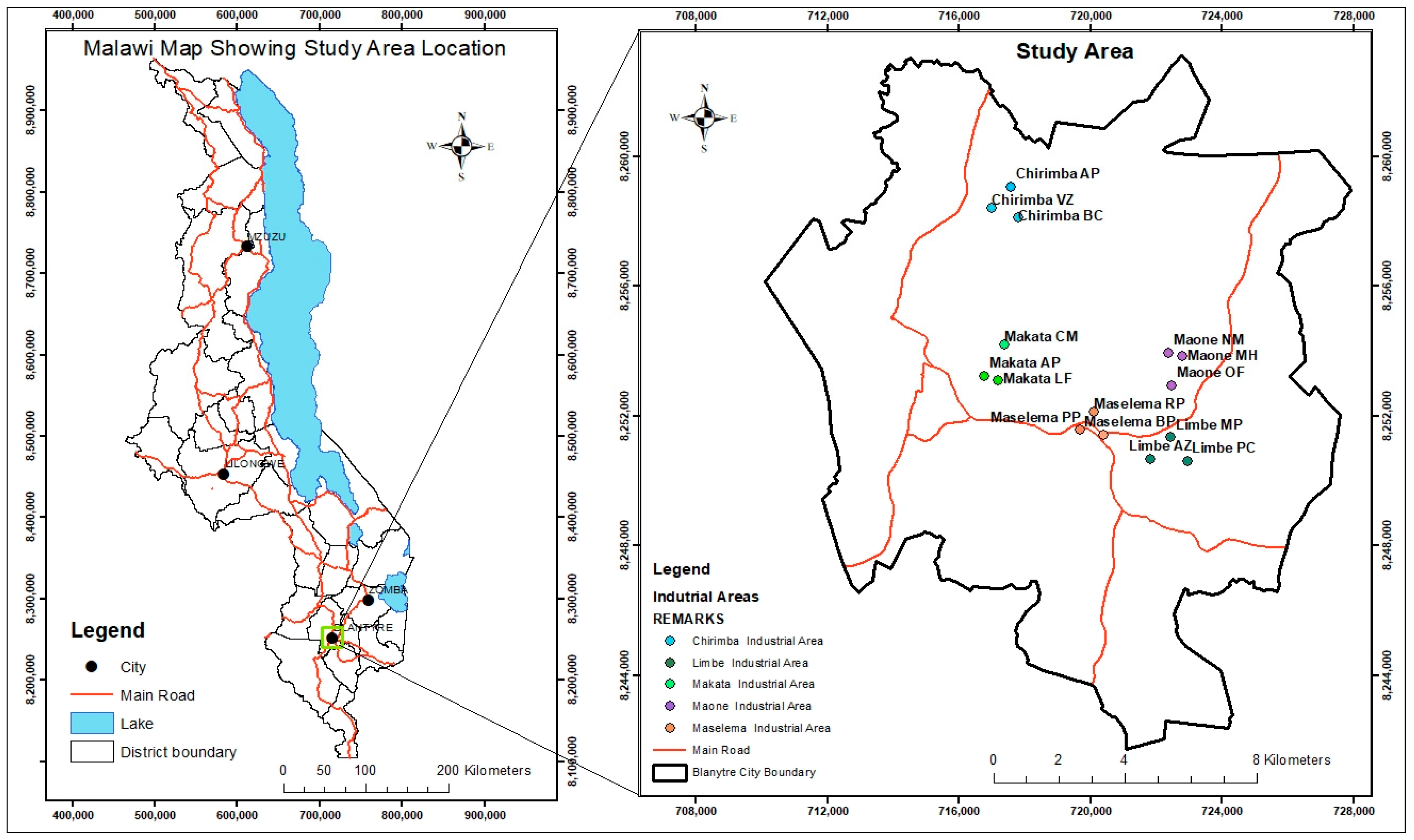


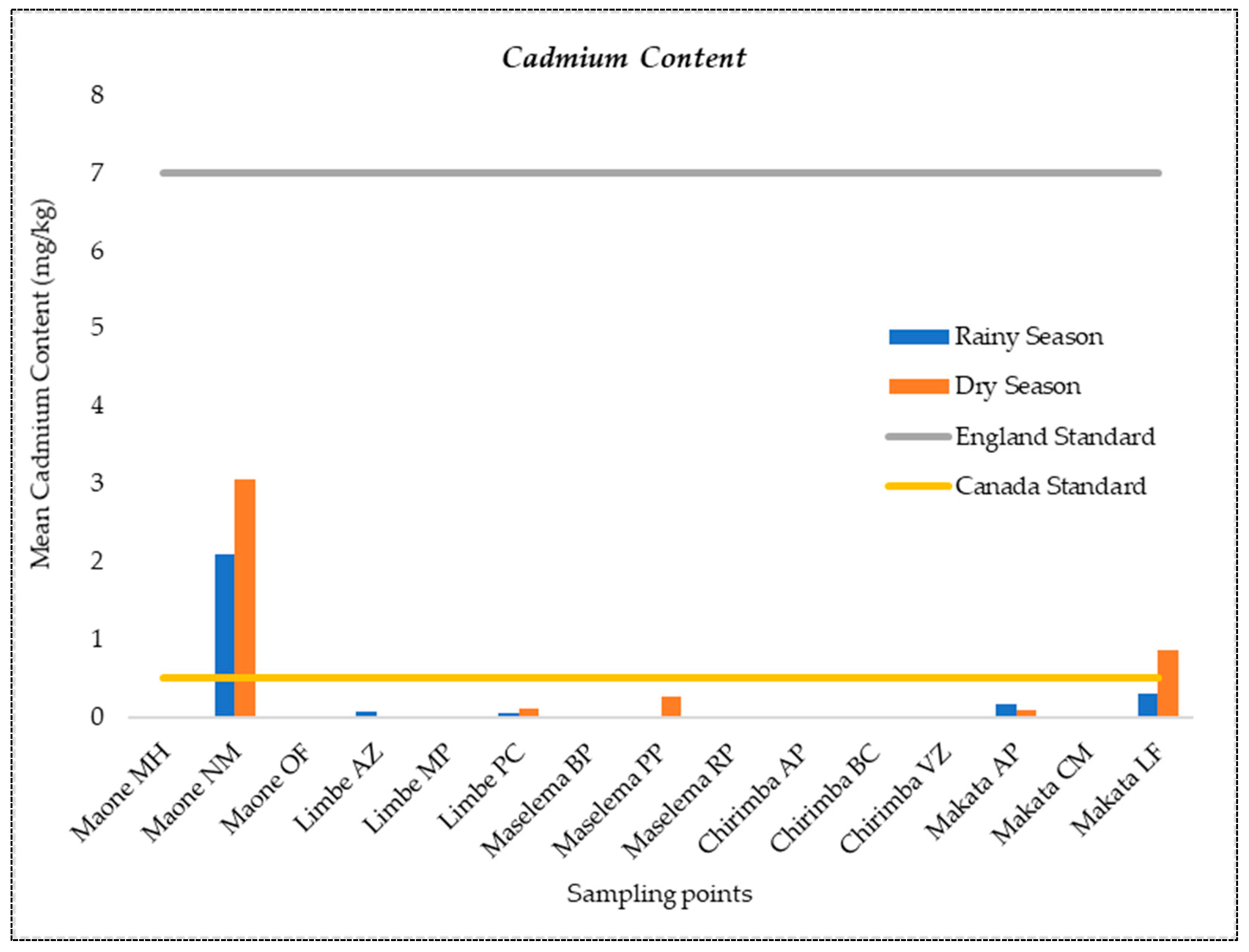
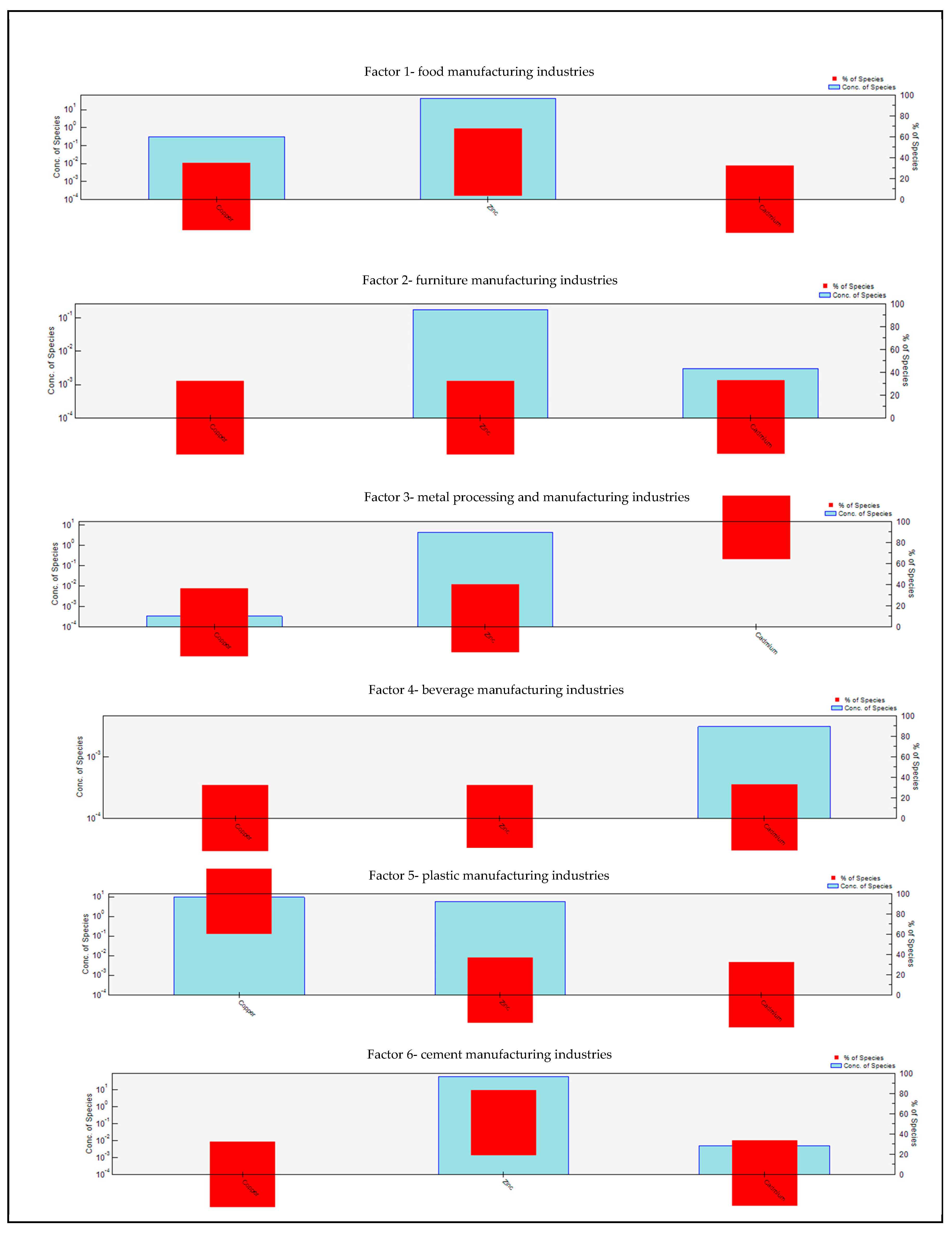
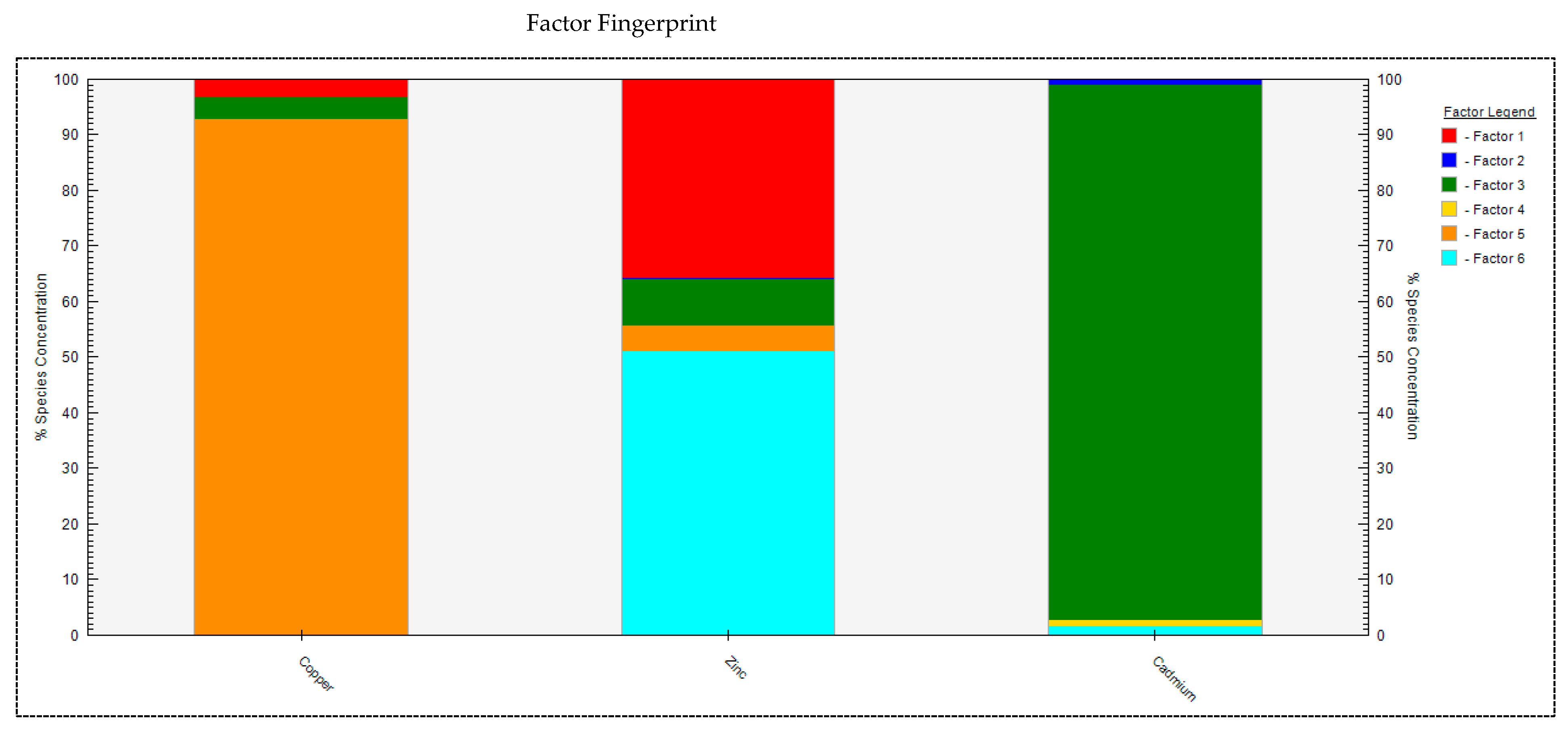


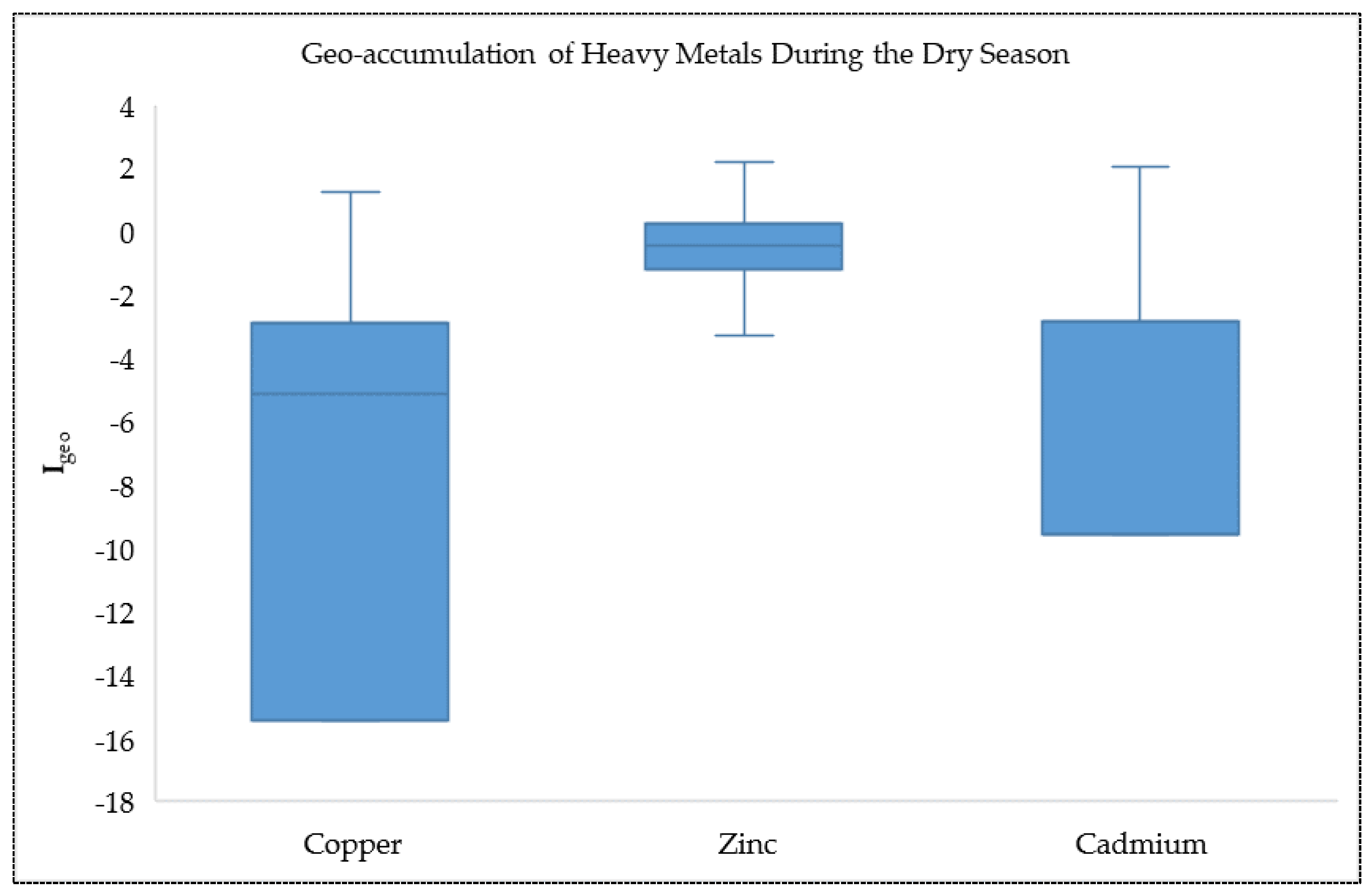
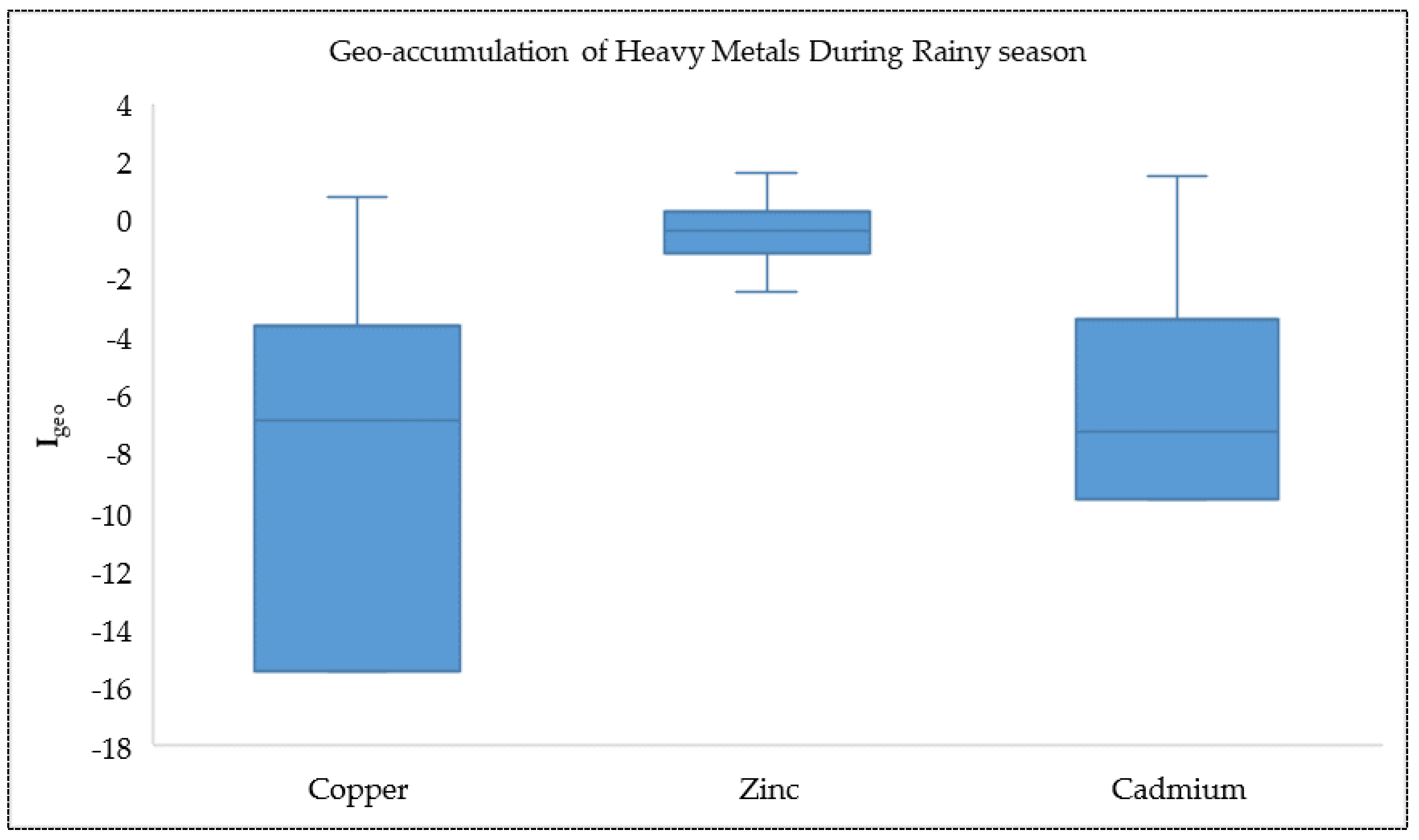
| Sampling Point | Location (UTM) | Cu (mg/kg) | Zn (mg/kg) | Cd (mg/kg) | |||
|---|---|---|---|---|---|---|---|
| Rainy Season | Dry Season | Rainy Season | Dry Season | Rainy Season | Dry Season | ||
| Maone MH | 722,465.48, 8,252,921.50 | BDL | BDL | 30.7 ± 2.91 | 27.9 ± 3.8 | BDL | BDL |
| Maone NM | 722,776.63, 8,253,824.17 | 3.21 ± 0.4 | 3.11 ± 0.84 | 68.4 ± 0.6 | 105 ± 11.1 | 2.09 ± 0.1 | 3.06 ± 0.1 |
| Maone OF | 722,362.96, 8,253,936.39 | 1.15 ± 0.24 | BDL | 71.2 ± 2.0 | 0.26 ± 0.11 | BDL | BDL |
| Limbe AZ | 721,243.21, 8,251,341.22 | BDL | BDL | 81.4 ± 1.30 | 69.3 ± 9.0 | 0.07 ± 0.01 | BDL |
| Limbe MP | 721,442.83, 8,251,262.55 | 1.51 ± 0.02 | 3.66 ± 1.0 | 192 ± 1.06 | 185 ± 13.8 | 0.02 ± 0.01 | BDL |
| Limbe PC | 721,442.83, 8,251,536.57 | 0.38 ± 0.05 | 1.26 ± 0.21 | 41.3 ± 1.05 | 59.6 ± 7.32 | 0.05 ± 0.04 | 0.11 ± 0.06 |
| Maselema BP | 719,681.90, 8,251,556.40 | 21.8 ± 0.7 | 14.3 ± 3.24 | 111 ± 0.9 | 94.8 ± 8.25 | BDL | BDL |
| Maselema PP | 719,820.04, 8,251,666.62 | BDL | 5.31 ± 1.71 | 104 ± 0.18 | 96.5 ± 1.7 | 0.02 ± 0.01 | 0.26 ± 0.07 |
| Maselema RP | 720,395.01, 8,251,396.02 | 14.6 ± 1.0 | 14.6 ± 1.0 | 70 ± 1.87 | 42.9 ± 1.93 | BDL | BDL |
| Chirimba AP | 717,577.34, 8,259,052.29 | 79 ± 1.4 | 105 ± 8.62 | 822 ± 2.3 | 579 ± 5.14 | BDL | BDL |
| Chirimba BC | 717,587.15, 8,258,489.82 | BDL | BDL | 51.2 ± 3.9 | 66.5 ± 1.84 | BDL | BDL |
| Chirimba VZ | 717,201.70; 8,258,647.93 | BDL | BDL | 3.95 ± 0.23 | 9.29 ± 1.0 | BDL | BDL |
| Makata AP | 717,182.33, 8,253,101.41 | 0.05 ± 0.01 | 0.22 ± 0.07 | 16.2 ± 0.33 | 39.1 ± 3.7 | 0.17 ± 0.01 | 0.09 ± 0.01 |
| Makata CM | 716,748.68, 8,253,219.58 | BDL | BDL | 55.5 ± 1.08 | 48.1 ± 3.3 | BDL | BDL |
| Makata LF | 717,841.57, 8,253,638.50 | 3.73 ± 0.19 | 6.13 ± 0.9 | 275 ± 10.54 | 408 ± 6.22 | 0.31 ± 0.4 | 0.87 ± 0.21 |
| England Standards | 100.00 mg/kg | 300.00 mg/kg | 7.00 mg/kg | ||||
| Canadian Standards | 30.00 mg/kg | 60.00 mg/kg | 50.0 mg/kg | ||||
| * Background Content | 0.2 | 0.5 | 0.6 |
| Signal-to-Noise Ratio (S/N) | ||
|---|---|---|
| Species | Dry Season | Rainy Season |
| Copper | 3.162 | 5.123 |
| Zinc | 7.319 | 9.956 |
| Cadmium | 1.769 | 2.289 |
| Igeo Class | Igeo Value | Level of Contamination Classification |
|---|---|---|
| 0 | Igeo ≤ 0 | Not contaminated |
| 1 | 0 < Igeo < 1 | Not contaminated to moderately contaminated |
| 2 | 1 < Igeo < 2 | Moderately contaminated |
| 3 | 2 < Igeo < 3 | Moderately to highly contaminated |
| 4 | 3 < Igeo < 4 | Highly contaminated |
| 5 | 4 < Igeo < 5 | Highly to extremely contaminated |
| 6 | Igeo ≥ 6 | Extremely contaminated |
Disclaimer/Publisher’s Note: The statements, opinions and data contained in all publications are solely those of the individual author(s) and contributor(s) and not of MDPI and/or the editor(s). MDPI and/or the editor(s) disclaim responsibility for any injury to people or property resulting from any ideas, methods, instructions or products referred to in the content. |
© 2025 by the authors. Licensee MDPI, Basel, Switzerland. This article is an open access article distributed under the terms and conditions of the Creative Commons Attribution (CC BY) license (https://creativecommons.org/licenses/by/4.0/).
Share and Cite
Utsale, C.C.; Kaonga, C.C.; Thulu, F.G.D.; Chiipa, P.; James, S.; Kosamu, I.B.M. Source Apportionment and Risk Assessment of Heavy Metals in Soils During Dry and Rainy Seasons in Southern Malawi. Pollutants 2025, 5, 6. https://doi.org/10.3390/pollutants5010006
Utsale CC, Kaonga CC, Thulu FGD, Chiipa P, James S, Kosamu IBM. Source Apportionment and Risk Assessment of Heavy Metals in Soils During Dry and Rainy Seasons in Southern Malawi. Pollutants. 2025; 5(1):6. https://doi.org/10.3390/pollutants5010006
Chicago/Turabian StyleUtsale, Constance Chifuniro, Chikumbusko Chiziwa Kaonga, Fabiano Gibson Daud Thulu, Petra Chiipa, Stellah James, and Ishmael Bobby Mphangwe Kosamu. 2025. "Source Apportionment and Risk Assessment of Heavy Metals in Soils During Dry and Rainy Seasons in Southern Malawi" Pollutants 5, no. 1: 6. https://doi.org/10.3390/pollutants5010006
APA StyleUtsale, C. C., Kaonga, C. C., Thulu, F. G. D., Chiipa, P., James, S., & Kosamu, I. B. M. (2025). Source Apportionment and Risk Assessment of Heavy Metals in Soils During Dry and Rainy Seasons in Southern Malawi. Pollutants, 5(1), 6. https://doi.org/10.3390/pollutants5010006






